Question and Answer — May 2013
If you’d like Neil’s help with a plant question, we’d love to hear from you. Because this is a visual medium, Neil requires a photo for any question he addresses here. Also, he’ll choose questions that will appeal to the greatest number of our readers, so plant IDs of volunteer seedlings probably won’t make the cut. Your local nursery can certainly help there. Those little provisos out of the way, here are his answers to this month’s questions.
Question: These beetles (I always called them June bugs) have been feasting on our oak trees each night. When we first planted the container oaks 12 years ago, we would spray them at night and kill the bugs, but now the trees are just too tall to do that. We treated the lawn for grubs on March 18, 2013, hoping to get rid of the problem. As you can see, it didn’t. Do you think the leaves will come back, and what can we do next year to help avoid the problem? R. and B. E., Tyler.
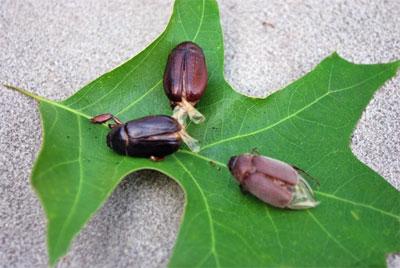
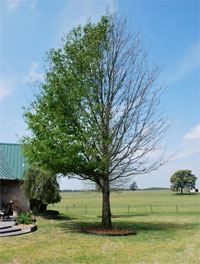 Answer: This has been perhaps the most interesting question we have received in more than 10 years here at e-gardens. I sent your photos to Bill Seaman, certified arborist with Arborilogical Services in DFW. He’s my go-to tree guy for our various publications. I also sent them to my longtime friend Dr. Mike Merchant, entomologist with Texas A&M AgriLife Extension.
Answer: This has been perhaps the most interesting question we have received in more than 10 years here at e-gardens. I sent your photos to Bill Seaman, certified arborist with Arborilogical Services in DFW. He’s my go-to tree guy for our various publications. I also sent them to my longtime friend Dr. Mike Merchant, entomologist with Texas A&M AgriLife Extension.
Rather than trying to edit their replies back and forth, I’m pretty much going to copy and paste them here for you.
• Mike replied first:
“This is one of our early emerging scarab beetles, probably Phyllophaga — the same genus as our June beetle, but not the same species. I am unaware of Phyllophaga crinita (the June beetle) ever causing significant tree damage.
“These are one-generation-per-year insects, so as the adults die off quickly, they will not come back. The trees generally re-leaf, but may need a little help to recover from the stress.”
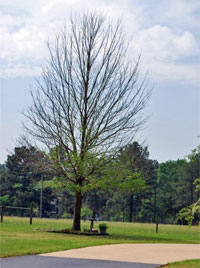 • Then Bill sent his ideas:
• Then Bill sent his ideas:
“I’m going to take this a different direction. While I appreciate the photos of the June bugs, I think they are coincidental and directing the reader off the sleuthing trail.
“I’m seeing defoliation by forest tent caterpillars. The time of year is right. They are feeding at night. And, they may be massing in places during the day where they are difficult to see.
“The pattern of defoliation on the tree is consistent with the way they move up and down as they feed.
“I have noticed that red oak foliage and Boston ivy foliage seem to be their foods of choice in our area.
“Without going to the location, and without additional information that would indicate otherwise, I’m going with forest tent caterpillar.”
• Mike must have forwarded the note to Dr. Robert Crocker, an entomologist cohort of Mike’s. Mike sent me back Dr. Crocker’s comments:
“The greyish beetle may be Phyllophaga rubiginosa and one or both of the glabrous specimens may be Phyllophaga congrua — hard to be sure without keying them out, and that would require having both a key and the actual specimens (neither of which I have at the moment).
“The tree foliage isn’t like anything I’ve seen Phyllophaga cause (half the tree bare bottom-to-top or [on the other tree] only the lowest branches with foliage). I noticed that the leaf they are on doesn’t show signs of having been fed on. Could this be a root disease? Perhaps (depending on the distribution of the pathogen around the particular tree) the laterally defoliated tree would have damage to roots on that side of the tree, whereas, the other tree might have symmetrically distributed root damage. As I understand it, vascular transport tends to be fairly much straight-line vertical, so damage to one side of the tree might not affect the other side initially.”
• And Mike added:
“I just figured that perhaps the beetles flew in on one side of the tree with prevailing wind, but on reflection it does seem a bit odd. Did the tree owner notice any leaf skeletonization? I’d have the same questions with forest tent caterpillars — why the odd defoliation pattern? I’ve never seen them do this, but I can’t say I’ve personally observed lots of FTC infestations either. I guess we need more information.
• Bill took me out of the middle (I was pretty much useless anyway) and responded to Mike directly:
“I have watched these critters’ feeding patterns because their movement through trees fascinates me. My thought is — on one tree, the eggs were deposited only on one side of the tree. They caravan up and down, following previous tracks as long as they have food. There seems to be little deviation horizontally on the trunk. With eggs deposited in several locations in the tree, there is a greater likelihood of the general defoliation. Note that in one of the photos the lower foliage remains. I think this is because this insect may be wired for vertical movement. Just observations on my part.
“Bugs are strange.
“If this was done by FTC, the ground would be covered with droppings. Now, with the foliage gone, and their guts full, they have come out of the tree and are traveling the country, looking for a good place to pupate.”
• Finally, Mike, his day now consumed by my inquiry, replied:
“I think FTC is a definite possibility. The answer will lie with the homeowner doing a little more homework, looking for caterpillars and/or June beetle look-alikes under and on the tree. It could be that the beetles were collected from under a nearby lamppost, and that they are not the culprits. Either way, this should be a one-time deal — both insects have one generation per year. I would like to know for my own benefit what kind of critter does this sort of damage.”
And he added this a few minutes later:
“I forgot to reiterate that you are right — treating for grubs at this time of year is useless. July (Aug-Oct) is the only time of year when it makes any sense to treat white grubs. These beetles, if the problem is caused by the beetles, flew in from Lord knows where, and treating the soil has no impact on the likelihood of those beetles being there.”
• R. and B. E. from Tyler, you got a lot of help from three of Texas’ best on this one. My contribution: Apply an all-nitrogen fertilizer and water deeply. New foliage should emerge soon, if it hasn’t already.
Question: The bark on one of my mature post oaks is showing damage. The tree was on the property when I built my home 14 years ago, and it has always looked healthy. Any suggestions for what I should do? J.C., Flower Mound.
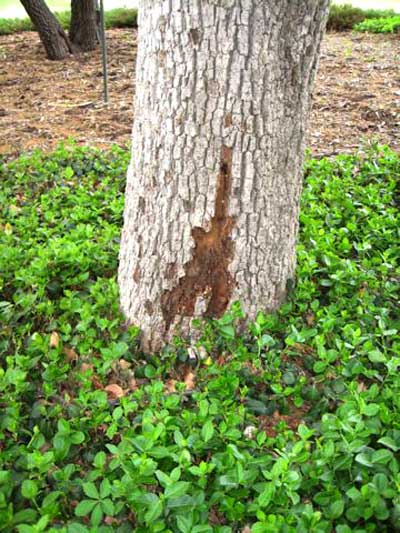
Answer: You probably ought to get a certified arborist on site, rather than trying to doctor this yourself. Anytime I see oak bark falling off, I am always concerned about Hypoxylon canker. It’s a process that is accelerated by extreme drought like we had in 2011, also by other environmental challenges. Unfortunately, post oaks face a lot of those challenges because basically they don’t like humans invading their territories. Get a good arborist to help you, and the tree can probably be turned around.
Question: I covered my sago palm with a tarp when we were given a freeze warning this past winter. It remained covered two days. It looked like this when I removed the tarp, and it still does. What can I do? K., Arlington.
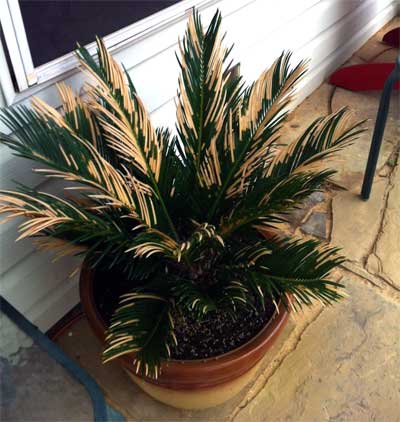
Answer: This is cold damage. Covering a plant that is exposed to more cold than it normally can handle will help a little, but not in extreme situations. Plus, a plant that is in a pot is more vulnerable to cold than the same plant would be if its roots were down in the soil. Sagos are sub-tropical. They’re not going to be reliable in North Texas, either in covered pots or in the ground, during most winters. Use an old sheet, frost cloth or towels to cover tender plants. Tarps don’t breath, they’re heavy, and they’re often dark, which means they soak up the sun’s rays, and that leads to rapid overheating. As new leaves emerge this season, trim off the old ones. Keep the plant indoors when temperatures fall into the 20s or colder in future winters.
Question: I planted quite a few ajuga plants beneath three sizeable oaks last year. They were looking just fine this spring, until something started killing them off very quickly. The nursery told me it was a fungus, and I sprayed that day. However, it has continued to spread. Strangely, I have other plants just 10 or 15 feet away, and they look fine. What can I do? L.M., no city given.
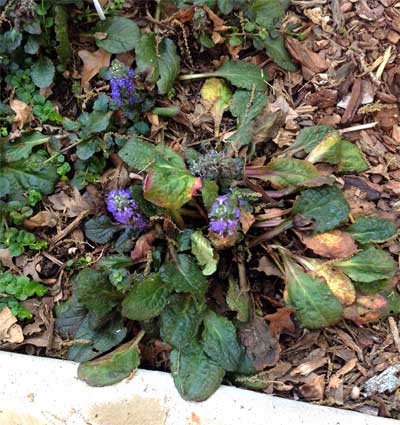
Answer: I have lived the same nightmare. Because ajuga was inexpensive and easily propagated and because I was broke and needed hundreds of plants for several shade beds, I grew many flats of it right out of my own gardens. Then, about 25 years ago it started dying in spots throughout the plantings. Unfortunately, fungicides didn’t stop the disease’s progress through the beds, and I was left to find another groundcover. It’s a soil-borne fungus that attacks a wide range of plants. I’d have to say that ajuga must be near the top of its list. Here is information from the TAMU Plant Disease Handbook. Click through to the southern blight portion and you’ll see even more.
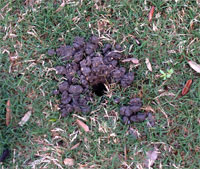 Question: I’ve recently moved into a newly constructed home. I have had a problem with something digging small, very deep holes in the yard. The holes are in the sodded areas as well as some mulched beds. I saw these same holes before construction, when the lot was vacant. Sometimes a mound of dirt will be around the hole, but other times it is not. I am wondering if these are the result of mole crickets? I also thought about crawfish, but I think they prefer sandy soil, and my soil is very much clay. If these are the result of mole crickets, then how should I treat them? I’ve heard they can do severe damage. S.S. Frisco.
Question: I’ve recently moved into a newly constructed home. I have had a problem with something digging small, very deep holes in the yard. The holes are in the sodded areas as well as some mulched beds. I saw these same holes before construction, when the lot was vacant. Sometimes a mound of dirt will be around the hole, but other times it is not. I am wondering if these are the result of mole crickets? I also thought about crawfish, but I think they prefer sandy soil, and my soil is very much clay. If these are the result of mole crickets, then how should I treat them? I’ve heard they can do severe damage. S.S. Frisco.
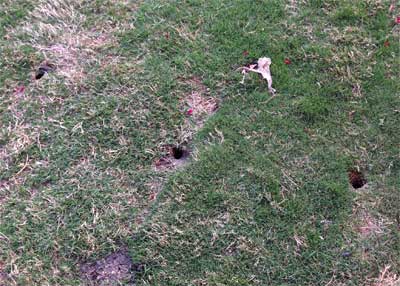
Again, I prevailed on Dr. Mike Merchant of Texas A&M AgriLife Extension. Here is his reply:
“My guess would be crawdads. Mole crickets are tunnelers, excavating tunnels just below and parallel to the surface. Especially if the lawn is in a lower, wetter site, crawdads would be the likely critter.”
If there is a way to redirect water and improve subsurface drainage in the meanwhile, that would help a great deal.
Question: We planted a beautiful Texas ash last fall. It started to grow this spring, but the green balls froze and turned brown. Since then, nothing has happened. What is wrong with it? No name, no city given.
Answer: Those were flower buds. If the tree still hasn’t leafed out at this late date, you probably have lost it. I have seen ash species fail to survive very late freezes that hit once they had started to grow. However, your tree may also have been hit by ash borers. They normally don’t attack for the first couple of years, but it’s possible they’re involved. The third possibility would be that the tree got too dry at some point in late winter and early spring. Somewhere in there is the answer. Hope I’ve given you enough information to get started.
Question: Our Indian hawthorns are struggling. They all have these brown spots on their leaves, and one has actually died. What can be done to save them? P.G., no city given.
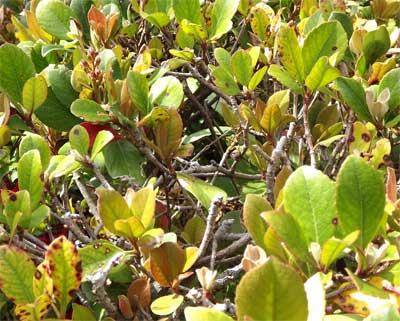
Answer: This (sadly) is Entomosporium fungal leaf spot. That’s the disease that has so ravaged redtip photinias, and it is now making its way through the Indian hawthorn population. It begins with the b-b-sized maroon freckles, then it leads to yellowed foliage, dead twigs and eventually, dead plants. As with redtips, control is very challenging. Here is what North Carolina State University has to say. I tried fungicides on my own Indian hawthorns for several years, and eventually I found it more expedient to replace them with plants such as Carissa hollies.
Question: I am planning on starting a garden for an orphanage in Haiti. I’m thinking that soil isn’t going to be very good for vegetables. How would it work to use pots? What plants would grow best in containers? What would do best in Haiti’s tropical climate? A.C.
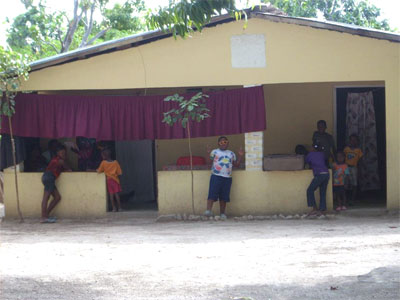
Answer: Yes, to container gardening, although it will take a lot of pots and potting soil to get enough to provide significant food. In-ground gardens are always much more productive. As to the types of crops, I think I had a similar question on my Facebook page. If my answer is repetitious, please forgive me. I believe my advice was to ask the people involved for a list of the types they enjoy the best, then do a little homework on how those plants are grown. Finally, you could pick the ones that were most practical for you to do. I found a ton of matches for Haitian recipes and gardening in support of their people. Good job, and good luck with it!
Question: This fruitless mulberry was planted more than 50 years ago, and it is far beyond time to replace it. Would a ‘Teddy Bear’ magnolia, crape myrtle or redbud be suitable? It will be done this fall. J.W., Fort Worth.
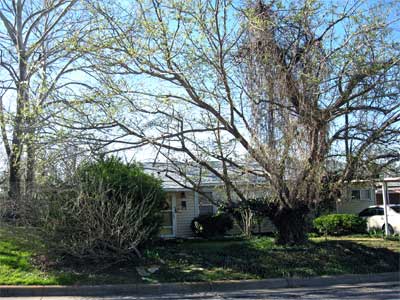
Answer: Head-scratcher alert! I think I’m seeing English ivy groundcover beneath the tree. That would go away (due to sun) if the tree were removed. The new tree, whatever type you chose, wouldn’t provide enough shade to protect it for 5 or 10 years. Also, ‘Teddy Bear’ is the smallest of the southern magnolias, growing to 15 to 18 feet tall and 12 to 15 feet wide. Would that really be “enough tree” for this spot? ‘Little Gem’ dwarf southern magnolia grows taller, and you could get a nice specimen in a larger container for quicker results. I might be tempted to remove the lowest limbs of any magnolia in this area, just so I wouldn’t be blocking the view to and from the house. A redbud might be nice, especially one of the improved selections that have now become commonplace. As much as I like crape myrtles, having one as the sole shade tree in a yard seems to me to be expecting a little too much of it. All of which leads me to ask: if the mulberry is still healthy, what would happen if you had a certified arborist clean it up by removing unwanted branches, also the vines that have climbed into its canopy? The ivy would thank you, and you’d continue getting nice shade. Mind you, fruitless mulberries rarely live as long as yours has, so if it’s in any form of decline, one of the replacements may well be the best option.


